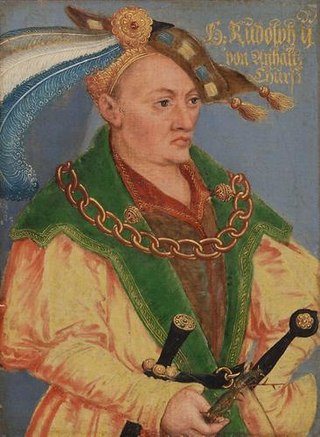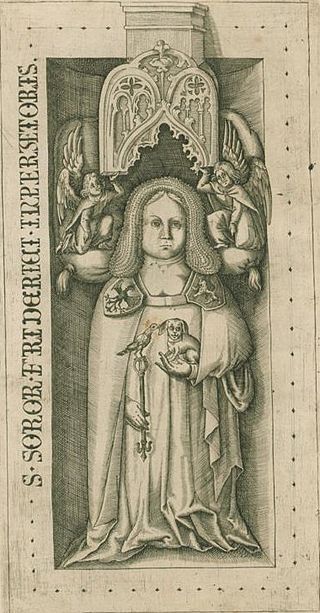Related Research Articles

Boniface, OSB was an English Benedictine monk and leading figure in the Anglo-Saxon mission to the Germanic parts of Francia during the eighth century. He organised significant foundations of the church in Germany and was made bishop of Mainz by Pope Gregory III. He was martyred in Frisia in 754, along with 52 others, and his remains were returned to Fulda, where they rest in a sarcophagus which remains a site of Christian pilgrimage.

The Büraburg was a prominent hill castle with historic significance, on the Büraberg hill overlooking the Eder river near the town of Fritzlar in northern Hesse (Germany). Only foundation walls remain, and a church dedicated to St. Brigida.

Donar's Oak was a sacred tree of the Germanic pagans located in an unclear location around what is now the region of Hesse, Germany. According to the 8th century Vita Bonifatii auctore Willibaldo, the Anglo-Saxon missionary Saint Boniface and his retinue cut down the tree earlier in the same century. Wood from the oak was then reportedly used to build a church at the site dedicated to Saint Peter. Sacred trees and sacred groves were widely venerated by the Germanic peoples.

Saint Lullus was the first permanent archbishop of Mainz, succeeding Saint Boniface, and first abbot of the Benedictine Hersfeld Abbey. He is historiographically considered the first official sovereign of the Electorate of Mainz.

June 4 - Eastern Orthodox Church calendar - June 6
Otloh of St Emmeram was a Benedictine monk, composer, writer and music theorist of St Emmeram's in Regensburg.

Hygeburg, also Hugeburc, Hugeberc, Huneberc or Huneburc, was an Anglo-Saxon nun and hagiographer at the Alemannian monastery of Heidenheim. She is "the first known Englishwoman to have written a full-length literary work" and "the only woman author of a saint's life from the Carolingian period".
Eigil was the fourth abbot of Fulda. He was the nephew and biographer of the abbey's founder and first abbot Saint Sturm. We know about Eigil primarily from the Latin Life that the monk and teacher of Fulda, Candidus Bruun composed about him after his death.
Sturm, also called Sturmius or Sturmi, was a disciple of Boniface and founder and first abbot of the Benedictine monastery and abbey of Fulda in 742 or 744. Sturm's tenure as abbot lasted from 747 until 779.

The Hülfensberg is a 448 m high, heavily wooded mountain in the Geismar municipality in the Eichsfeld district, Thuringia, Germany. The mountain has been a pilgrimage site since the late Middle Ages, and on its summit are a church containing a 12th-century crucifix, a Franciscan friary, a chapel dedicated to Saint Boniface, and a large free-standing cross.

Rudolf II, Duke of Saxe-Wittenberg, nicknamed Rudolf the Blind, was a member of the House of Ascania. He was Elector of Saxony and Duke of Saxe-Wittenberg from 1356 until his death. He was the eldest son of Duke Rudolf I of Saxe-Wittenberg and his wife, Judith of Brandenburg-Salzwedel.

Ludwig II, Landgrave of Thuringia, nicknamed Louis the Iron.

Judith of Hohenstaufen, also known as Judith of Hohenstaufen or Judith of Swabia, a member of the Hohenstaufen dynasty, was Landgravine of Thuringia from 1150 until 1172 by her marriage with the Ludovingian landgrave Louis II. She was baptized as Judith, but was commonly called Jutta or Guta. Sometimes the Latinate form Clementia was used, or Claritia or Claricia.

Louis III, nicknamed Louis the Pious or Louis the Mild was a member of the Ludowingians dynasty who ruled as Landgrave of Thuringia from 1172 until his death.
Lutz E. von Padberg is a German historian whose specialty is medieval history and in particular the Christianization of the Germanic peoples. He is an expert on Saint Boniface, having written biographies of the saint and studies of his veneration.

The Ragyndrudis Codex is an early medieval codex of religious texts, now in Fulda in Germany, which is closely associated with Saint Boniface, who, according to tradition, used it at the time of his martyrdom to ward off the swords or axes of the Frisians who killed him on 5 June 754 near Dokkum, Friesland. This long association has given the codex the status of a contact relic.
Petra Kehl is a German scholar of the Middle Ages, specifically of the veneration of saints. Kehl's monograph Kult und Nachleben des hl. Bonifatius (1993) is one of two monographs on the veneration of Saint Boniface. Her study was praised by one reviewer as written "with meticulous care", and by another as "an account that deserves wide recognition, a standard for scholarship for years to come". Kehl lives in Fulda, where she runs a publishing company specializing in historical fiction, religious literature, and children's literature.
Withego von Furra or de Wuor, otherwise Withego I of Meissen or Withego I von Furra was Bishop of Meissen from 1266 to his death.

St Severus' Church in the city of Erfurt in Thuringia, Germany, is a Roman Catholic church building. It stands on the Domberg directly next to St Mary's Cathedral. As a unique architectural ensemble, both churches together form the city's landmark. Due to its unusual form, which seems to anticipate the late Gothic hall church, St Severus' Church is one of the most important Gothic buildings in Germany. The bones of the church patron Severus of Ravenna rest in an artistically very significant sarcophagus.
References
- ↑ Willibald (1905). "Vita Bonifatii Auctore Willibaldo". In Wilhelm Levison (ed.). Vitae Sancti Bonifati Archiepiscopi Moguntini. Hahn. pp. 1–58., p. 31, translated in Talbot, C.H. (1954). The Anglo-Saxon Missionaries in Germany: Being the Lives of S.S. Willibrord, Boniface, Sturm, Leoba and Lebuin, together with the Hodoeporicon of St. Willibald and a Selection from the Correspondence of St. Boniface'. Sheed and Ward. pp. 45–46.
- ↑ Levison 60.
- ↑ Levison 87.
- 1 2 Farmer, David (1997). Oxford Dictionary of Saints. Oxford UP. p. 163. ISBN 978-0-19-280058-9.
- ↑ Monks of Ramsgate. "Eoban". Book of Saints 1921. CatholicSaints.Info. 5 December 2012
 This article incorporates text from this source, which is in the public domain .
This article incorporates text from this source, which is in the public domain .